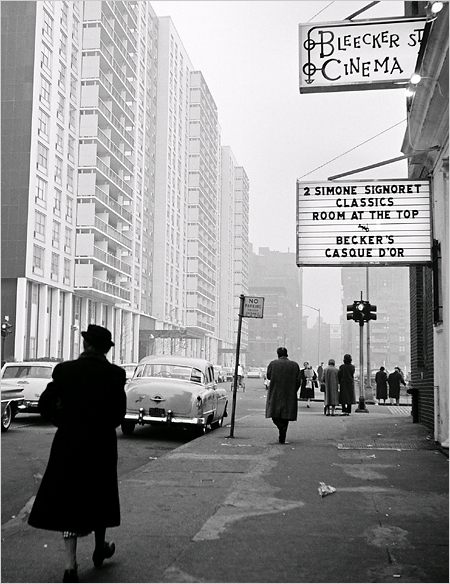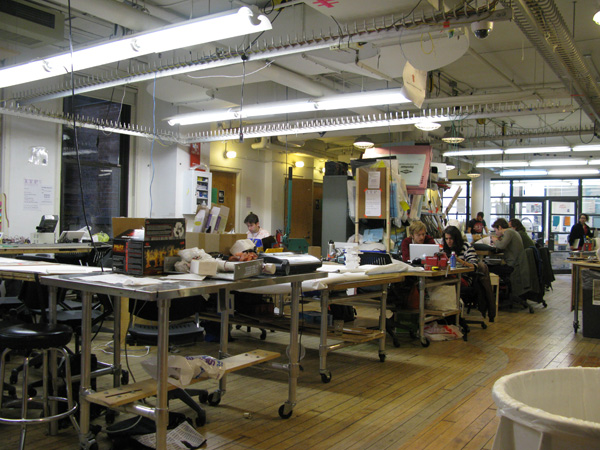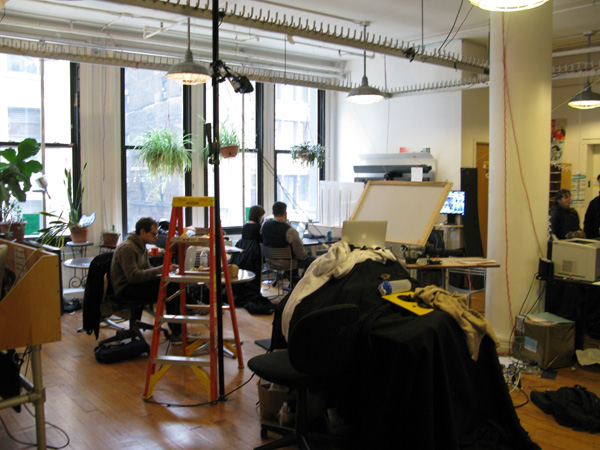4th Floor of ITP at 721 Broadway, photo by Jason Huff
NYU’s ITP (Interactive Telecommunications Program) celebrated its 30th anniversary in 2009, but much of the program dates back to forty years ago. The graduate program is “dedicated to pushing the boundaries of interactivity in the real and digital worlds.” This year is also a landmark year as founder Red Burns is starting to archive the program's history. The archive is beginning just as New York City, with its thriving startup scene, is starting to feel geeky enough to be a natural home for the innovative program.1 Beyond its original intentions, the program is pioneering in "physical computing," as coined by a faculty member. It has even managed intellectual property policies that let students keep full ownership of their ideas.

Bleecker Street Cinema circa 1970, photo by Robert Otter via Soho Memory Project
The year the AMC started was the same year Sony introduced the first portable video recorder—the Portapak. The units cost around $1500 to buy, but according to a New York Times article from that year, they could be rented for $75 a day. Burns and her collaborator, George Stoney, with backgrounds and interests in film and video, focused the AMC on exploring Sony’s new tool and its potential to help create interactive and community-driven television broadcasts. Their hope was to change one-way television produced by dominant national networks into a local two-way experience.
Burns and Stoney used their new organization to build a team of volunteers that shared similar interests in radicalizing community driven television. Their earliest programs were designed to train community groups to use the then new technology. In Manhattan, the AMC offered free workshops on how to use the Portapak. One of their earliest projects helped a community in Washington Heights: they were unable to convince authorities, through traditional methods, of their need for a traffic light at a dangerous intersection. The AMC helped them make a video advocating the need for the traffic light. It aired on September 25th at 4 P.M. in 1971, just four months after the AMC launched. It was a two hour broadcast from the intersection of Audoboun Avenue and 184th street and showed, according to McCandlish Phillips of the New York Times, “protesters gathering [in] the streets… their refusal to leave [and] discussions with a sergeant and later a captain.” The light was installed soon after, and the Alternate Media Center—despite Burn’s stated wish to “stay under the radar”—was already making headlines.
The rest of the AMC’s early accolades were earned organizing nationally funded collaborative trails for creating two-way community television in the rural northeast. Their first big project was in Reading, PA in 1975. They teamed up with a local television network, working with senior citizens, city officials, and community organizers. Collaboratively they produced short programs that covered topics such as “citizen-government interaction” but also included quiz shows and a weekly report on things happening around Reading, PA called “The Changing Face of Reading.” A project a few years later in Vermont focused on teaching children with Cerebral Palsy new technologies for creating digital content. The AMC applied for large grants to complete their work, some from the NSF, and subsequently earned more press — winning awards from institutions like the National Cable Television Association among others.

Red Burns, image via ITP
In 1983, Burns became director of the Interactive Telecommunications Program (ITP)2, a new graduate program at NYU inside the Tisch School of the Arts that she’d built on the shoulders of what the AMC had begun. Its mission was different than the AMC’s in that it was to train students to experiment with all kinds of new technologies, not just video. Unlike other programs of its type, it had no technical prerequisites for admissions and sought a professionally diverse group of applicants. Although the ITP was born in the same Bleecker Street space where the AMC started, it moved a year later, in 1980, to its current home: the fourth floor of NYU’s Tisch building at 721 Broadway. In its inaugural year, ITP accepted 20 students. The AMC continued to operate, but went inactive later that decade.
After my interview with Burns, she gave me an archive of her reports and articles spanning from 1977 to 1998. Reading through them, I uncovered a presentation she gave at the American Council on Education in Washington D.C., on October 16, 1981, titled “Technology is Not Enough”. For a presentation in 1981, the title still holds certain relevance. I discovered what might have been the guiding principles of the earliest days of the ITP program. She laid out two points in working with technology: 1) “consider the technology as a tool which, in itself, could do nothing,” and 2) “treat the technology as something that everyone on the team could learn, understand, and explore freely.” This was a similar formula she had developed in her research projects with the AMC and she has iterated and relied on it ever since.

Physical Computing workshop on the 4th floor at ITP, photo by Jason Huff
As technology continued to dramatically change throughout the early 2000s, the program responded in the most organic ways it could. It kept hiring recent alumni and adding new courses to the curriculum. Daniel Shiffman, one of the current programming professors, was a student at ITP from 2001 to 20033 and stayed on an extra year as a “resident researcher”. In a short email exchange, he explained the evolution of programming at ITP. When he arrived, the core programming course, titled “Introduction to Computational Media”, taught students Macromedia Director (now Adobe Director) and its propriety coding language Lingo. But there wasn’t one particular coding language that dominated the curriculum, until with the help of O’Sullivan, Shiffman created a course called "Procedural Painting" in 2004 which used Processing. The course was a success, and according to Shiffman, Processing became the new language taught in the "Introduction to Computational Media" course in the Fall of 2004.4
The architecture and enrollment aren’t the only things that have changed over the years. And curriculum change wasn’t always dictated by software and hardware. While O’Sulivan was a student in 1989, he took a course on copyright, which was designed to help students secure their ideas in the marketplace, own them, and protect them from being shared or stolen. Now the same course teaches students the opposite of what was taught in 1989 — the new version outlines how to share works legally and freely under GNU and GPL with open source communities. In some ways the new version is much truer to the program’s roots.
Over email O’Sullivan explained how ITP has accommodated so many changes over the years: “The program is pretty agile [and] evolutionary, so we change a little every year—which heads off big cataclysmic changes. Doubling the space of the floor and accepting more students was one big positive landmark. The Dot Com boom did bring the culture in a slightly bad direction but the bust brought it back.” Some alumni, like Dennis Crowley creator of Dodgeball (which was bought by Google one year after he graduated) and Foursqure, have had quick success in the New York startup community, but O’Sullivan says, “most of our students have a more normal success pattern that takes longer.”

ITP's home at 721 Broadway in the Tisch School of the Arts, photo by Jason Huff
As Burns and I wrapped up our conversation in her office, she showed me a book that documented a congressional committee she was on that determined national policy for broadcast television in the early 80s. Pausing for a minute to describe her legacy on the fourth floor and the current mix of students at ITP, she said she was continually awestruck. In the beginning of her career starting the AMC she worked hard and, in her words, “loved every minute of it.” But amidst that hard work, she had forgotten to create a formal archive of the last forty years.
As she moved around her office, continuing the search for the initial grant proposal that gave the AMC its original home just above Bleecker Street Cinema, we looked at some photos and talked about the future of the program. When asked if the program would continue she answered sharply: “If it has any value it will, if it doesn’t, it wont.”
You can visit ITP's Winter Show on the 4th floor of the Tisch building at 721 Broadway this Sunday (Dec. 18th) 2-6 P.M. and Monday (Dec. 19th) 5-9 P.M., to see current students’ projects as they rearrange the open space on the floor to present their ideas and the spirit of ITP.
(1) Correction Dec 16, 2011: Originally the article stated that "Red" Lloyd Burns is retiring and leaving the program. This was a error and has been changed to correct her name and highlight the archive started to collect the program's history.
(2) Correction Dec 15, 2011: Martin Elton was the original chairman of the ITP program in 1979, until Red Burns became chairman in 1983.
(3) Correction Dec 15, 2011: Daniel Shiffman was a student until 2003 not 2002.
(4) Correction Dec 16, 2011: Daniel Shiffman was not the creator of the first Processing course at ITP. He created the course called "Procedural Painting" in 2004 which used Processing. The course was a success, and according to Shiffman, Processing became the new language taught in the "Introduction to Computational Media" course in the Fall of 2004.



Check out this video on YouTube:
http://www.youtube.com/watch?v=9muzyOd4Lh8&feature=youtube_gdata_player
Sent from my iPhone
The essence of Tummo Yoga is the recognizing that outer phenomena are the mirror to one's own mind. This practice of meditation may be best known for its alleged ability to produce body heat. The outcome of this practice, as claimed by Indian accomplishers, or mahasiddhas, is an intensely blissful feeling. In the Kagyu tradition of Tibetan Buddhism, Tummo belongs to the Six Yogas of Naropa teachings, a set of practices used to recognize the nature of the mind.
Agree ….
Home Health Care
I Agree..
http://silvercensus.com/seniorcare-services/home-health-care
We agree Home Health
Animation Bump/Scenery Porn: Drop-dead gorgeous, even by Kyoto Animation's standards. The backgrounds are very highly detailed, seeing real-time perspective shifts in a 2D plane is not uncommon (although some Conspicuous CG is used where it would be otherwise too difficult and expensive to animate by hand, see below), the frames-per-second is remarkably high for its sort of anime.
http://www.youtube.com/watch?v=4zRkIbUi01k&feature=youtube_gdata_player